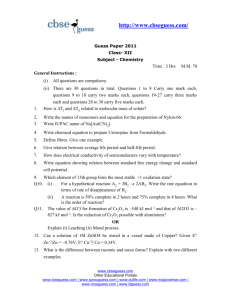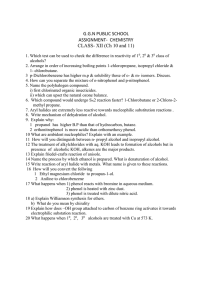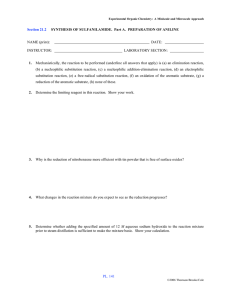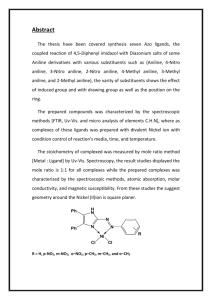DIVISION S-2-SOIL CHEMISTRY Kinetics of Phenol and Aniline Adsorption and Desorption
advertisement
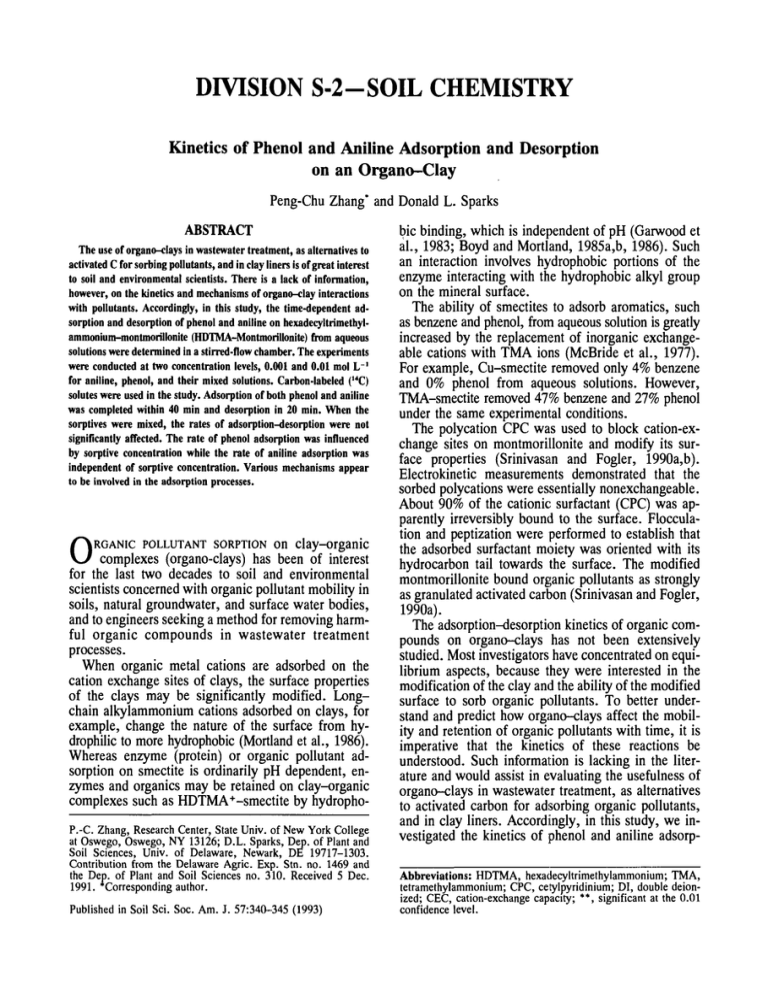
DIVISION S-2-SOIL CHEMISTRY Kinetics of Phenol and Aniline Adsorption and Desorption on an Organo—Clay Peng-Chu Zhang* and Donald L. Sparks ABSTRACT The use of organo-clays in wastewater treatment, as alternatives to activated C for sorbing pollutants, and in clay liners is of great interest to soil and environmental scientists. There is a lack of information, however, on the kinetics and mechanisms of organo-clay interactions with pollutants. Accordingly, in this study, the time-dependent adsorption and desorption of phenol and aniline on hexadecyltrimethylammonium-montmorillonite (HDTMA-Montmorillonite) from aqueous solutions were determined in a stirred-flow chamber. The experiments were conducted at two concentration levels, 0.001 and 0.01 mol L ' for aniline, phenol, and their mixed solutions. Carbon-labeled (14C) solutes were used in the study. Adsorption of both phenol and aniline was completed within 40 min and desorption in 20 min. When the sorptives were mixed, the rates of adsorption-desorption were not significantly affected. The rate of phenol adsorption was influenced by sorptive concentration while the rate of aniline adsorption was independent of sorptive concentration. Various mechanisms appear to be involved in the adsorption processes. O RGANIC POLLUTANT SORPTION on clay-organic complexes (organo-clays) has been of interest for the last two decades to soil and environmental scientists concerned with organic pollutant mobility in soils, natural groundwater, and surface water bodies, and to engineers seeking a method for removing harmful organic compounds in wastewater treatment processes. When organic metal cations are adsorbed on the cation exchange sites of clays, the surface properties of the clays may be significantly modified. Longchain alkylammonium cations adsorbed on clays, for example, change the nature of the surface from hydrophilic to more hydrophobic (Mortland et al., 1986). Whereas enzyme (protein) or organic pollutant adsorption on smectite is ordinarily pH dependent, enzymes and organics may be retained on clay-organic complexes such as HDTMA+-smectite by hydrophoP.-C. Zhang, Research Center, State Univ. of New York College at Oswego, Oswego, NY 13126; D.L. Sparks, Dep. of Plant and Soil Sciences, Univ. of Delaware, Newark, DE 19717-1303. Contribution from the Delaware Agric. Exp. Stn. no. 1469 and the Dep. of Plant and Soil Sciences no. 310. Received 5 Dec. 1991. *Corresponding author. Published in Soil Sci. Soc. Am. J. 57:340-345 (1993) bic binding, which is independent of pH (Garwood et al., 1983; Boyd and Mortland, 1985a,b, 1986). Such an interaction involves hydrophobic portions of the enzyme interacting with the hydrophobic alkyl group on the mineral surface. The ability of smectites to adsorb aromatics, such as benzene and phenol, from aqueous solution is greatly increased by the replacement of inorganic exchangeable cations with TMA ions (McBride et al., 1977). For example, Cu-smectite removed only 4% benzene and 0% phenol from aqueous solutions. However, TMA-smectite removed 47% benzene and 27% phenol under the same experimental conditions. The polycation CPC was used to block cation-exchange sites on montmorillonite and modify its surface properties (Srinivasan and Fogler, 1990a,b). Electrokinetic measurements demonstrated that the sorbed polycations were essentially nonexchangeable. About 90% of the cationic surfactant (CPC) was apparently irreversibly bound to the surface. Flocculation and peptization were performed to establish that the adsorbed surfactant moiety was oriented with its hydrocarbon tail towards the surface. The modified montmorillonite bound organic pollutants as strongly as granulated activated carbon (Srinivasan and Fogler, 1990a). The adsorption-desorption kinetics of organic compounds on organo-clays has not been extensively studied. Most investigators have concentrated on equilibrium aspects, because they were interested in the modification of the clay and the ability of the modified surface to sorb organic pollutants. To better understand and predict how organo-clays affect the mobility and retention of organic pollutants with time, it is imperative that the kinetics of these reactions be understood. Such information is lacking in the literature and would assist in evaluating the usefulness of organo-clays in wastewater treatment, as alternatives to activated carbon for adsorbing organic pollutants, and in clay liners. Accordingly, in this study, we investigated the kinetics of phenol and aniline adsorpAbbreviations: HDTMA, hexadecyltrimethylammonium; TMA, tetramethylamrnonium; CPC, cetylpyridinium; DI, double deionized; CEC, cation-exchange capacity; **, significant at the 0.01 confidence level. 341 ZHANG & SPARKS: PHENOL AND ANILINE ADSORPTION AND DESORPTION KINETICS tion-desorption on an organo-clay, HDTMAmontmorillonite. MATERIALS AND METHODS Experimental Procedures Montmorillonite (SWY-1, Crook Co., Wyoming) used in the study was obtained from the Source Clays Repository (Clay Minerals Society, Columbia, MO). It was suspended in a HC1 solution of pH 3 to remove carbonates. Then, H2O2 was added to the suspension and the suspension was placed in a water bath at 315 to 318 K for 6 h to oxidize the naturally occurring organic materials. The clay suspension was then dialyzed in a membrane tube immersed in DI water and the water was changed daily until the conductivity of the suspension equaled that of the DI water. The clay suspension was fractioned 2+ into the <2H,m fraction by centrifugation, saturated with Ca using 0.5 mol L- ' CaCl2, and dialyzed in DI water to wash out excess electrolyte. The HDTMA-montmorillonite was prepared using the procedure of Boyd et al. (1988). Hexadecyltrimethylammonium bromide (Aldrich Chemical Co., Milwaukee, WI) was added to the montmorillonite suspension in an amount that equaled the CEC of the montmorillonite clay, approximately 90 cmoy kg. After 2 h of standing, the organo-clay was washed with DI water and then freeze-dried. A static study was conducted to obtain adsorption isotherms. The HDTMA-montmorillonite (0.500 g) was placed in a 30mL centrifuge tube and a 14C-labeled phenol or aniline solution was added. Ionic strength 1in the suspension was adjusted to 0.01 M with a 0.1 mol L- CaCl? solution. After shaking the suspension for 6 h, the time at which equilibrium was attained, the suspension was centrifuged at 17, 210 x g for 20 min. A 1-mL aliquot of the supernatant solution was placed in a scintillation vial containing 10 mL of scintillation solution (ScintiVerse E, Fisher Scientific, Pittsburgh, PA). The activity of the radioactive isotope in the vial was determined with a Beckman LS 5000 TA scintillation counter (Beckman Instruments, Fullerton, CA). For each treatment, the same procedure was performed with a reference sample (phenol or aniline in CaCl? solution without HDTMA-montmorillonite). The adsorption of phenol or aniline was determined from the difference in activities of the treatment and its reference. We assumed that the 14C-labeled phenol or aniline molecules were adsorbed on the organo-clay like the unlabeled molecules. All experiments were conducted at a temperature of 297 ± 1 K and a measured pH of 6.4 ± 0.3. Kinetics of adsorption and desorption of phenol and aniline and a mixture of these two organics on HDTMA-montmorillonite were studied at concentrations of 0.001 and 0.01 mol L"1. The kinetics were studied using the stirred-flow reaction chamber first developed by Carski and Sparks (1985) and later modified by Toner et al. (1989). A magnetic stir star, 0.500 g of HDTMA-montmorillonite, and 5.0 mL of a 0.003 mol L- ' CaCl2 solution were placed in the chamber, complete with influent and effluent ports and a plunger base. A prefilter and filter were fitted just below the effluent port to retain the modified clay, a top was attached, and a known volume of CaCl2 solution was injected into the chamber. The plunger base was then used to displace the excess air from the chamber, thus enabling precise control of the reaction volume. An LKB 2132 Microperpex peristaltic pump (LKB-Produkt AB, Bromma, Sweden) was used to maintain a constant sorptive flow rate of 0.001 L min-'. The CaCl2 solution was passed through the chamber for 1 h to wash out any free HDTMA+ before the organic sorptive solution was introduced into the chamber. For adsorption studies, effluent was collected at 1-min intervals for the first 30 min and then at 2-min intervals. For the desorption experiments, effluent was collected every 1 min for the first 20 min and then at intervals of 2, 3, and 5 min. The adsorption-desorption procedures were followed without or- gano-clay to construct a dilution curve to distinguish the effects of dilution from adsorption and desorption effects on effluent concentration (Carski and Sparks, 1985; Sadusky and Sparks, 1991) and also to verify the equation derived to calculate the dilution factor, as discussed below. After running the CaCl2 solution through the chamber, 14Clabeled phenol or aniline solution was pumped through the chamber at a flow rate of 0.001 L min- 1 . Effluent was collected in vials containing 10 mL of scintillation solution. The adsorption studies were continued until an equilibrium in adsorption was attained. Following adsorption, desorption was effected by passing 0.003 mol L- ' CaCl2 through the chamber until an equilibrium was reached. Analysis of the organics was determined as described for the static studies. Analysis of Kinetic Data The quantity of phenol and aniline adsorption-desorption on HDTMA-montmorillonite was calculated from the differences in concentration of influent and effluent solutions at the time of sampling and in the dilution factor, defined below. For adsorption, the following equation was used to calculate the amount of organic material adsorbed on HDTMA-montmorillonite as a function of time: (2a = = I [(C, - Q/A/ - (C,+A, - C,)V]/m [1] where Qa = the cumulative amount adsorbed (mol kg-1); A#, + A/ = the amount adsorbed at time / to / + Af (mol 1 kg); Q = concentration of influent solution (mol L~'); C, = concentration of effluent solution from time Mo t + At (mol L-1); 1 J = flow rate (L min- ); A Af = time period of sample (min); C/+A/ = average concentration in the chamber from Mo t + Af (molL- 1 ); C, = average concentration in the chamber from t — 1 Ar tor (mol L- ); V = volume of chamber (L); m = mass of HDTMA-montmorillonite in the chamber (kg). In Eq. [1], the term (Cl+ A, - C,) is referred to as the dilution factor, which reflects the concentration change on the chamber during a time period t to / + A/. Because the relationship between concentration change and time in the chamber is not linear, the concentration in the effluent solution cannot be used simply as the concentration in the chamber. The average concentration in the chamber without adsorbent C,+A, can be obtained from the following equation: fA, At For desorption, the cumulative desorption as a function of time can be calculated from the following equation: <2d = [3] - C,JAt]/m 342 SOIL SCI. SOC. AM. J., VOL. 57, MARCH-APRIL 1993 where C,_A, and <?,+A, represent the average concentrations in certain period of time. The assumption of this test is that, if nonequilibrium conditions are present, stopping the flow for a time period sufficient for 50% of the reaction to be completed will allow the system to attain equilibrium (Seyfried et al., 1989). If the reaction is time dependent, the sorptive concentration in the stirred-flow chamber should decrease and, when flow is restarted, a discontinuity in the curve (drop in concentration) of relative effluent concentration vs. effluent volume will be observed. If the reaction is instantaneous, no drop in relative effluent concentration will be observed and the curve will be continuous (Bar-Tal et al., 1990). Before running the complete kinetic studies of phenol and aniline adsqrption-desorption on HDTMA-montmorillonite, a preliminary study, involving stopping adsorptive flow, was conducted to ascertain whether the reactions were kinetically controlled and could be measured using the stirred-flow method. Although not shown, plotting relative effluent concentration vs. effluent volume resulted in a sharp drop in effluent concentration after flow was stopped for 30 min in both the phenol and aniline studies. These results indicated that adsorption of both organics on HDTMA-montmorillonite was time dependent (Bar-Tal et al., 1990). To estimate the adsorption and desorption of organic compounds on HDTMA-montmorillonite, the concept of mass balance during a particular time period was applied, as expressed in Eq. [11 and [3], for adsorption and desorption, respectively. An estimation of concentration change in the chamber during a particular time period is critical, since the change is directly related to the adsorption and desorption, as shown in Eq. [1] and [3]. The concentration change in the chamber cannot be determined directly and can only be calculated. In the preliminary experiment, a comparison was made to examine the differences between the calculated concentration in the chamber with Eq. [2] and [4] and the concentrations in the effluent solutions (Fig. 2) when neither adsorption nor desorption, respectively, was occurring. There were differences existing between the concentrations in the chamber and in the effluent solution during the time period. Accordingly, Eq. [2] was combined with Eq. [1] and Eq. [4] was combined with Eq. [3] to calculate the cumulative adsorption and desorption, respectively. a continuously diluted chamber without adsorbent during a time period t to t + At and t to / - At, respectively, which can be obtained from the following equation: [4] where C0 is the concentration in the chamber at t = 0. RESULTS AND DISCUSSION Adsorption Isotherms Although not shown, there was little, if any, adsorption of phenol and only trace quantities of aniline adsorption on untreated montmorillonite (Sparks and Zhang, 1990). Phenol, a weak acid in aqueous solution, is not expected to adsorb on montmorillonite since the latter is hydrophilic and negatively charged. Such a finding was observed for a ferric oxide surface by Yost and Anderson (1984). Even though aniline has a molecular steric structure similar to phenol, it is a weak base and partially dissociates as an anion in aqueous solution. Therefore, aniline may adsorb on the montmorillonite surface through ion exchange or electrostatic attraction (Sparks and Zhang, 1990). Phenol and aniline adsorption were greatly enhanced on the HDTMA-montmorillonite (Fig. 1). Adsorption increased as the concentration of the organic adsorptive increased. The mechanism for the adsorption of organic compounds on HDTMA-montmorillonite is not clear, but adsorption appears to be a function of the solubility and polarity of the organic compounds in aqueous solutions (Boyd et al., 1988). In contrast to the unmodified montmorillonite surface, the surface of HDTMA-montmorillonite is more hydrophobic. This enhances the ad- sorption of compounds that are less soluble in aqueous solution. Kinetic Studies Bar-Tal et al. (1990) suggested a simple but necessary test for determining whether a reaction is instantaneous or kinetically controlled, using a stirred-flow reactor. The test involves stopping the flow of adsorptive for a J3>1500 c" o 1000 9- 8 Influent Concentration of Phenol = 0.001 moj/L Flux = 0.001 L/min No Solid HDTMA-Montmorillonite = 20g/L Ionic strength = 0.01 M 0 0 10 20 30 40 50 60 70 8 Concentration, mmol/L Fig. 1. Adsorption of phenol and aniline on HDTMAmontmorillonite. 10 20 30 40 SO Time, min Fig. 2. Comparison of theoretical calculations and experimental measurements for effluent concentrations in the stirred-flow chamber as a function of time. 343 ZHANG & SPARKS: PHENOL AND ANILINE ADSORPTION AND DESORPTION KINETICS D D D D D D D D D S. 150 •8 Influent Concentration = 0.001 mol/L Flux = 0.001 L/min Solid = 0.5 g Influent Concentration = 0.01 mol/L Flux = 0.001 L/min Solid = 0.5 g r£_ 0 10 20 30 40 50 0 60 10 20 30 40 50 60 Time, min Time, min Fig. 3. Kinetics of phenol adsorption on HDTMAmontmorillonite at an influent concentration of 0.01 mol L-'. Fig. 5. Kinetics of aniline adsorption on HDTMAmontmorillonite at an influent concentration of 0.001 mol L-1. A A A A A A A-. Influent Concentration = 0.01 mol/L Flux = 0.001 L/min Solid = 0.5 g Influent Concentration = 0.001 mol/L Rux = 0.001 L/m!n Solid = 0.5 g 0 10 20 30 40 50 60 Time, min Fig. 4. Kinetics of phenol adsorption-desorption on HDTMAmontmorillonite at an influent concentration of 0.001 mol L-1. Kinetics of phenol adsorption on HDTMA-montmorillonite at an influent concentration of 0.01 mol L~l are shown in Fig. 3. There was no significant increase in adsorption observed after 50 min. Phenol 1adsorption at an influent concentration of 0.001 mol L" is shown in Fig. 4, as well as the kinetics of phenol desorption. Phenol could not be completely desorbed from the HDTMAmontmorillonite; about 42% of the adsorbed phenol was subsequently desorbed in 30 min. Desorption was relatively rapid with little desorption occurring after 30 min. These data indicate that phenol adsorption-desorption on HDTMA-montmorillonite is nonsingular, i.e., irreversibility exists. Adsorption kinetics of aniline on HDTMA-montmorillonite at two aniline concentrations is shown in Fig. 5 and 6. Equilibrium in adsorption was established in about 40 min. Unlike phenol, the amount of aniline adsorption seems proportional to the concentration in the 1solution. Total adsorption was 14.2 and 132 mmol kg- with the 0.001 and 0.01 mol L"1 solutions, respectively. The adsorption is approximately proportional to the adsorptive concentration in the solution. Desorption kinetics were investigated at the higher aniline concentration. About 70% of adsorbed aniline was desorbed within 30 min. (Fig. 6). Time, min Fig. 6. Kinetics of aniline adsorption-desorption on HDTMAmontmorillonite at an influent concentration of 0.01 mol L-1. I 5 Phenol (0.001 mol/L) + Aniline (0.001 mol/L) Flux = 0.001 L/min Solid - 0.5 g 30 Time, min Fig. 7. Kinetics of phenol and aniline adsorption-desorption on HDTMA-montmorillonite from influent concentrations of 0.001 mol L-1 of phenol and aniline mixed. To examine the influence of possible competitive adsorption on the kinetics of the two organics, adsorption of phenol and aniline on HDTMA-montmorillonite from the mixed solutions was conducted (Fig. 7 and 8). When mixed solutions (0.001 mol L-1) of phenol and aniline 344 SOIL SCI. SOC. AM. J., VOL. 57, MARCH-APRIL 1993 1 "5 e E200 AA A A A A A A A A A A A A Aniline Concentration = 0.01 or 0.001 mol/L Solid = 0.5 g Phenol (0.01 mol/L) + Aniline (0.01 mol/L) Flux = 0.001 L/min Solid = 0.5 g A* A* AA 0 0 10 20 30 40 50 60 Time, min Fig. 8. Kinetics of phenol and aniline adsorption on HDTMAmontmorillonite from influent concentrations of 0.01 mol L~' of phenol and aniline mixed. 10 20 30 40 50 60 Time, min Fig. 10. Adsorbed fraction of aniline vs. time at two influent concentrations, 0.01 and 0.001 mol Lr1. a> o. c o phenol at 0.01 mol/L aniline at 0.01 mol/L D A phenol at 0.001 mol/L aniline at 0.001 mol/L Phenol concentration = 0.01 or 0.001 mol/L Solid = 0.5 g 30 40 50 60 Time, min 0 10 20 30 40 50 60 Time, min Fig. 9. Adsorbed fraction of phenol vs. time at two influent concentrations, 0.01 and 0.001 mol L~'. were used, the total amount of phenol and aniline adsorbed was 27.5 and 12.5 mmol kg-1, respectively. These amounts were lower than the amount of phenol (35 mmol kg"1) and aniline (15 mmol kg-1) adsorbed when only one adsorptive was studied. This may indicate that competitive adsorption occurred. However, when the mixed organic solution concentration was 0.01 mol L"1, the amount of phenol and aniline adsorption was 270 and 175 mmol kg"1, respectively. Adsorption of phenol and aniline from individual,1 unmixed solutions was lower, 225 and 132 mmol kg" , respectively (significant F-test at 0.01 probability level for both phenol and aniline). A possible explanation for these results may be that, at the higher concentration of the mixed adsorptives, the adsorbed organics may further modify the surface and, consequently, the ability of the surface to adsorb organics is enhanced. The rates of adsorption and desorption were not significantly different for the mixed- and single-organic solutions. Approximately 63.6 and 64% of the adsorbed phenol and: aniline, respectively, were desorbed when 0.001 mol L" mixed adsorptive solutions were used. Again, only partial reversibility in organic adsorption on the modified clay was observed. In an attempt to develop models for describing the Fig. 11. Adsorbed fraction of mixed phenol and aniline vs. time at influent concentrations of 0.01 mol L~* and 0.001 mol L-1 each of phenol and aniline. kinetics of phenol and aniline retention on HDTMAmontmorillonite, tests were conducted to distinguish the reactions in which the adsoqstion rates are dependent or independent of the influent concentration. To accomplish this, the flow rates or influent concentration can be changed (Bar-Tal et al., 1990). According to Bar-Tal et al. (1990), if adsorbed fraction vs. time does not change with various flow rates or influent concentrations, the adsorption reaction may be classified as one in which the adsorptive concentration does not influence reaction rates. If the reaction rates are dependent on the influent concentration, the adsorbed fraction vs. time will be a function of flow rates or concentration (Bar-Tar et al., 1990). Two influent concentrations were used in the study with aniline, phenol, and mixtures of the two organics. Changes in phenol influent concentration affected the adsorbed fraction as shown in Fig. 9. With a phenol concentration of 0.01 mol L"1, an adsorption equilibrium was attained faster than that observed for a 0.001 mol L"1 phenol solution. There is a significant difference (significant F-test at 0.05 probability level) between the two curves of adsorbed fraction vs. time for the first 40 min. In contrast to phenol, there was no effect of aniline influent concentration on the adsorbed fraction versus time (Fig. 10). The same phenomena, as shown in Fig. 11, were observed for adsorption of phenol and aniline ZHANG & SPARKS: PHENOL AND ANILINE ADSORPTION AND DESORPTION KINETICS from mixtures of the two organics at two influent concentrations. The curves of adsorbed fraction of aniline as a function of time at the two concentrations overlapped, but the curves describing phenol adsorption were similar to those observed when phenol was the only adsorptive. These results lead to the conclusions that the rate of aniline adsorption on HDTMA-montmorillonite is independent of solution concentration, whereas the rate of phenol adsorption is concentration dependent (BarTal et al., 1990). Both phenol and aniline adsorption on HDTMAmontmorillonite were partially reversible. These results may indicate that adsorption does not follow a single mechanism. Modification of the clay surface by adding a large organic molecule such as HDTMA complicates the nature of the surface, which may show both hydrophilic and hydrophobic as well as electrostatic properties. The properties of the modified surface vary with coverage of the surface with large molecules (Boyd et al., 1988). Therefore, adsorbed phenol or aniline may be retained via various mechanisms. Some of the adsorbed molecule may be weakly bound to the surface and can be desorbed, while the organic may be strongly bound to other parts of the adsorbent and cannot be easily removed. For example, adsorption of the organics from the mixed solutions was different from that when only one organic was added. Of course, to obtain definitive mechanisms for organic contaminant adsorption-desorption on organo-clays, molecular data needs to be gathered. Such information could be obtained by employing surface spectroscopic techniques. 345
